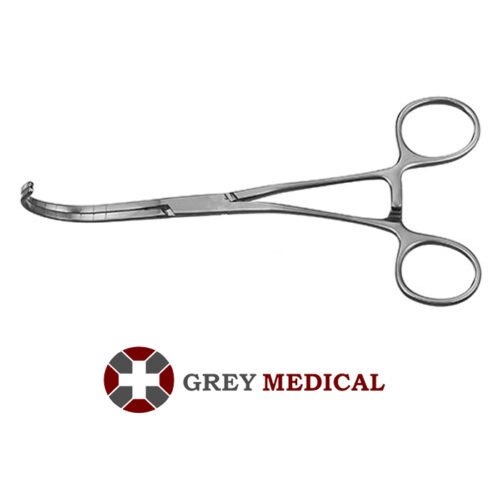
In the intricate world of cardiovascular and thoracic surgery, precision, control, and minimal tissue damage are critical factors that influence the success of procedures. Among the arsenal of tools that surgeons rely upon, the Cooley clamp stands out as a fundamental instrument. Named after the pioneering cardiovascular surgeon Dr. Denton Cooley, this cooley clamp has revolutionized the approach to vascular surgeries. Its design and functionality have made it an indispensable tool in operating rooms around the globe.
The Anatomy of the Cooley Clamp
The Cooley clamp is a specialized surgical instrument used to temporarily occlude blood flow in veins and arteries during surgery. It is designed to be both effective and gentle, preventing blood flow without causing undue trauma to the tissues. This delicate balance is achieved through its unique construction.
Atraumatic Jaws: One of the key features of the Cooley clamp is its atraumatic jaws. These jaws are often curved and coated with soft, non-damaging materials or designed with smooth surfaces to evenly distribute pressure. This minimizes the risk of vessel damage during occlusion, making the clamp ideal for delicate tissues and crucial in surgeries where precision is paramount.
Ergonomic Design: The handles of the Cooley clamp are designed for ease of use, allowing surgeons to apply and release the clamp with minimal effort. This ergonomic design reduces hand fatigue during lengthy procedures and enhances the overall control surgeons have during critical moments.
Variety of Sizes: Cooley clamps are available in various sizes and lengths, catering to different surgical needs. This versatility allows them to be used across a range of procedures, from large vessels in cardiac surgeries to smaller, more delicate vessels in pediatric or microvascular surgeries.
Applications of Cooley Clamps in Surgical Procedures
The Cooley clamp is predominantly used in cardiovascular and thoracic surgeries, where controlling blood flow without causing permanent damage is crucial. Some of the primary applications include:
Coronary Artery Bypass Grafting (CABG): In CABG procedures, the Cooley clamp is used to occlude the aorta temporarily, allowing the surgeon to attach a graft to bypass a blocked coronary artery. The clamp’s precision ensures minimal blood loss and creates a stable field for the grafting process.
Aortic Aneurysm Repair: When repairing an aortic aneurysm, it is essential to isolate the affected section of the aorta. The Cooley clamp facilitates this by temporarily stopping blood flow, giving the surgeon a clear view and control over the repair process.
Heart Valve Replacement: During valve replacement surgeries, blood flow needs to be controlled precisely to replace the malfunctioning valve with a prosthetic one. The atraumatic nature of the Cooley clamp ensures that the blood vessels remain intact and undamaged during the process.
Vascular Anastomosis: In procedures that require joining two vessels, such as in the creation of an arteriovenous fistula for dialysis access, the Cooley clamp provides the necessary control to connect the vessels accurately and securely.
The Evolution and Impact of the Cooley Clamp
Before the development of the Cooley clamp, surgeons faced significant challenges in controlling blood flow during operations. The introduction of this clamp brought a new level of control and safety, significantly improving patient outcomes. The ability to temporarily occlude blood vessels without causing damage reduced the risk of complications such as bleeding and thrombosis.
The Cooley clamp also played a crucial role in the advancement of minimally invasive surgical techniques. Its precise control is invaluable in procedures involving small incisions, where the surgical field is limited. As a result, patients benefit from shorter recovery times, less postoperative pain, and reduced risk of infection.
Maintenance and Care of Cooley Clamps
To ensure the longevity and effectiveness of Cooley clamps, proper maintenance and sterilization are essential. These instruments are typically made from high-quality stainless steel, which is resistant to corrosion and can withstand repeated sterilization. After each use, the clamp should be cleaned thoroughly to remove any blood or tissue residues. It is then sterilized using standard hospital protocols to ensure it is free from contaminants for the next procedure.
Regular inspection of the clamp is also important. Surgeons and operating room staff should check for any signs of wear or damage, such as dulling of the jaws or stiffness in the handles. Any issues should be addressed immediately to prevent malfunctions during surgery.
Future Developments in Surgical Clamps
As surgical techniques continue to evolve, so too do the instruments used in these procedures. Future developments in Cooley clamps and other surgical instruments may include the integration of advanced materials, such as biocompatible polymers, which could further reduce the risk of tissue damage. Innovations may also focus on enhancing the ergonomics of the clamp, providing even greater control and comfort for the surgeon.
Additionally, the incorporation of smart technology could lead to the development of clamps that provide real-time feedback on the pressure being applied to tissues, further minimizing the risk of injury and improving surgical outcomes.
Conclusion
The Cooley clamp is a testament to the importance of innovation in surgical instruments. Its design and functionality have transformed the landscape of cardiovascular and thoracic surgery, offering surgeons the precision and control necessary for successful outcomes. As medical technology advances, the role of the Cooley clamp will continue to be pivotal, ensuring that complex procedures can be performed with the utmost safety and efficiency. Whether in a bustling metropolitan hospital or a rural clinic, the Cooley clamp remains a vital tool in the ever-evolving field of surgery.